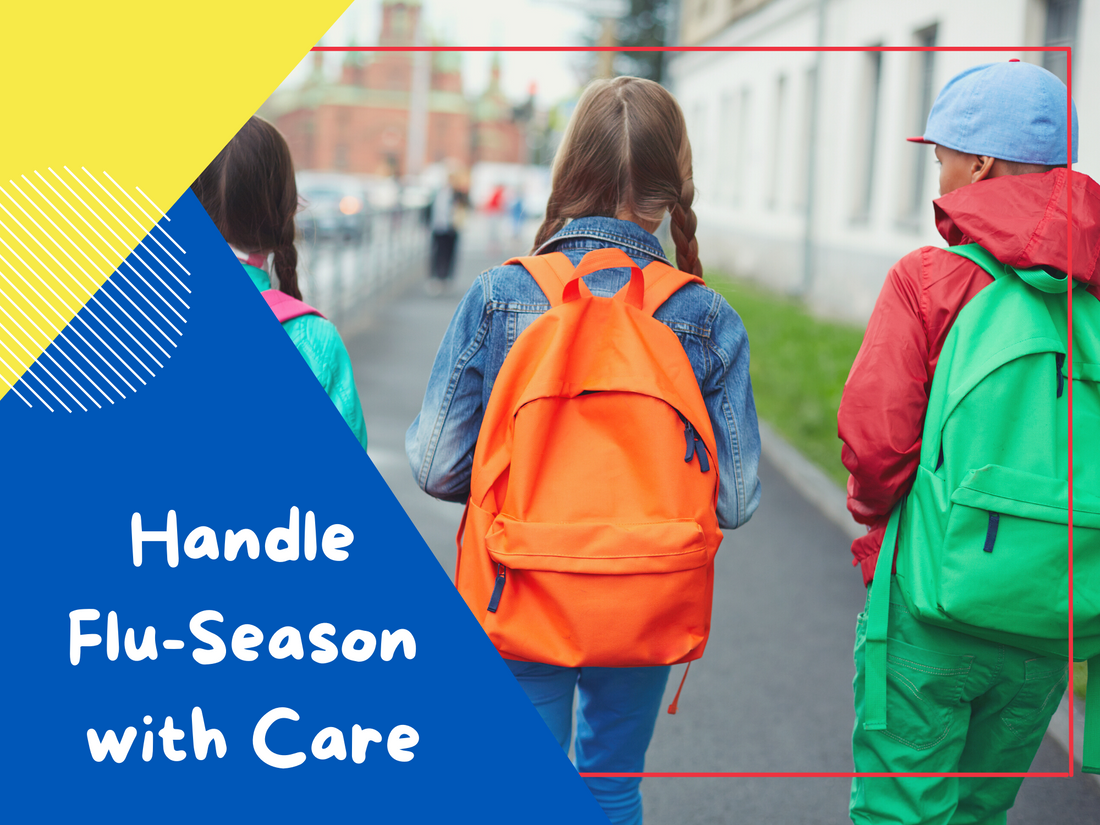As a student and a teacher, I have appreciated online learning. However, learning face-to-face in real-time is so much better.
Unfortunately, teaching in person brings its challenges, too. Spreading illnesses (flu, stomach bugs, covid, etc.) is magnified during the school year as asymptomatic, symptomatic, and healthy students come to class and interact every day.
If we want to keep teaching in person, we must prevent illnesses from spreading in the classroom.
Staying home when you don’t feel good is a great start. But there’s so much more we can do in the classroom to protect ourselves and our students from needing to take a sick day.
Educate and Practice Good Hand Hygiene
We touch everything with our hands: ourselves, other people, surfaces, and items other people touch. So, it makes sense that if we don’t keep our hands clean, people get sick. A study published in 2009 found that mandatory handwashing practices reduced absences in elementary schools by as much as 26%.
Although this seems like common sense, consider talking to your students about how to wash their hands. A surprising amount of people are uneducated on how to properly wash their hands. This is even more important during the cold and flu season. One study found that good handwashing instruction significantly decreases absences.
When washing your hands, keep the following in mind:
- Wash your hands for AT LEAST 20 SECONDS under running water. This is the minimum amount of time required to remove microscopic germs.
- Make sure to completely dry your hands after washing. It’s harder to spread germs with dry hands than wet ones.
- Use a paper towel to turn off the sink and open the bathroom door. This will help you keep your hands clean after washing them.

Today, many people prefer hand sanitizer instead of soap and water. However, soap and water have been found to kill germs that hand sanitizers cannot (such as diarrhea-causing germs). Soap and water also get hands cleaner. If you are going to use hand sanitizer, here are some tips to be the most effective:
- Use enough of it to get your hands completely wet. (The hand sanitizer label gives directions if you are unsure.)
- Let the sanitizer dry on your hands. So often, we dose our hands in sanitizer, only to dry them off with a towel. This defeats the purpose of hand sanitizer.
- Use hand sanitizer that is at least 60% alcohol! According to the Centers for Disease Control and Prevention, hand sanitizers with less than 60% alcohol only reduce germ growth and are ineffective for many types of germs.
Whether you are using hand sanitizer or soap and water, make sure to clean your hands frequently: especially before and after eating and after using the bathroom.
When in doubt, scrub it out!
Stock up on Tissues
Not only do we have to clean our hands well, but we also have to take steps to keep them clean.
Sick or not, everyone sneezes and coughs. However, how we choose to contain our sneezing makes a big difference in others getting sick.
You should always sneeze or cough into a tissue (preferable), the crook of your elbow, or down the front of your shirt. You should never sneeze or cough into your hands. If you do, wash them immediately.
To help encourage students to contain their sneezing, make sure you always have tissues available in the classroom.
I know that this is hard for teachers as schools don’t usually provide tissues. It’s usually best to work with the students to make sure your class is stocked with tissues. When I was in high school, different school clubs would give you extra points if you brought in tissues. If you’re an elementary school teacher, you can ask parents to donate tissues.
Clean Regularly
No matter how well you wash your hands or contain your sneezing, eventually, the things you and your students touch will become contaminated with germs. Regularly cleaning your classroom will help keep everyone healthy.
You should clean high-touch surfaces every day. This includes wiping down the desks, doorknobs, water fountains, and light switches.

Regularly take out the garbage. Wear gloves while taking out the trash to prevent picking up germs from used tissues.
Be careful to read and follow all directions on the disinfectants you use to clean your classroom. If you teach younger kids, make sure they are stored somewhere out of reach for little hands. Wear gloves while using them and ventilate your classroom (by running fans or opening windows) while cleaning to reduce breathing in fumes.
Get all of Your Vaccines
Smallpox is the only human disease to ever be eradicated. We did it with vaccines. In a study on the impacts of nine vaccine-preventable diseases, vaccinations were found to reduce the cases of all nine diseases by at least 90%. Another study estimated that if low and middle-income countries invested in vaccines, they could save $586 billion that would have been spent on health care for sick individuals.
Making sure you are up to date on your vaccines does more than just protect you; if enough people do their part, it protects public health as a whole.
This is referred to as “herd immunity.” Herd immunity means the chance of an unvaccinated (thus unprotected) person coming in contact with someone who has the illness is significantly reduced. And the potential for spreading the illness is reduced, too.

Educate your students on vaccines. Knowledge is power. Some people are hesitant about vaccines because they have been misinformed about them.
Vaccines go through vigorous testing to ensure that they are safe. Often it takes 10-15 years for a vaccine to be cleared by the FDA for public use. Even after it’s been cleared, vaccinations and the facilities where they are produced are closely monitored to ensure the product is functioning as it should.
Another common misconception is that being vaccinated protects you from ever getting the illness. Vaccinations only prepare your immune system for an encounter with the disease, reducing the severity of your symptoms if you do get it. This is still a huge help as it can reduce recovery time, hospitalizations, and deaths. For example, a 2018 study of adults hospitalized for the flu found those who had gotten the flu vaccine spent on average fewer days in the hospital and were less likely to be admitted to the ICU than unvaccinated individuals.
Some people cannot get vaccinations (whether for religious reasons, allergies, or others). These people are relying on herd immunity to stay healthy. By getting your vaccination and educating your students on vaccines, you are helping anyone who interacts with your student to stay healthy.
The Take Home
Little things make a big difference. Germs smaller than the eye can see can make us extremely sick. Keeping our hands clean, stocking up on tissues, regular disinfecting, and getting immunized can save lives and keep our schools open.
Teacher Power
Teacher Power wants you and your students to be in the best of health, so you can continue to empower the next generation. Our products are designed to give you the energy you need without added sugar. We even have a new immunity boost product to help you beat off the microbes that inevitably survive despite your ruthless cleaning efforts.

Keep reading our blog for resources to aid you in the classroom. Thanks for inspiring the world one student at a time.
The content of Teacher Power’s website is for information only, not advice or guarantee of outcome. Information is gathered and shared from reputable sources; however, Teacher Power is not responsible for errors or omissions in reporting or explanation. No individuals, including those taking Teacher Power products, should use the information, resources or tools contained within to self-diagnosis or self-treat any health-related condition. Teacher Power gives no assurance or warranty regarding the accuracy, timeliness or applicability of the content.
By: Emeline Haroldsen
Sources:
“Classroom Health 101: 5 Basic Illness Prevention Tips”. Teladoc. https://www.teladoc.com/health-talk/classroom-health-101-5-basic-illness-prevention-tips\
“Show me the science – when and how to use hand sanitizer in community settings”. CDC. 2020. https://www.cdc.gov/handwashing/show-me-the-science-hand-sanitizer.html
“Frequent Questions About Hand Hygiene”. CDC. 2020. https://www.cdc.gov/handwashing/faqs.html
Peri, Camille. “Germs in the School Room”. WebMD. 2011. https://www.webmd.com/children/features/germs-in-school-room
“Cleaning and Disinfecting Your Home”. CDC. 2021. https://www.cdc.gov/coronavirus/2019-ncov/prevent-getting-sick/disinfecting-your-home.html
Orenstein, Walter A, and Rafi Ahmed. “Simply put: Vaccination saves lives.” NCBI. 2017. https://www.ncbi.nlm.nih.gov/pmc/articles/PMC5402432/
“The Science Behind Vaccine Research and Testing”. New York State Department of Health. 2014. https://www.health.ny.gov/prevention/immunization/vaccine_safety/science.htm
“Classroom Cleaning Checklist”. Servicemasterclean. https://www.servicemasterclean.com/clean-blog/school-cleaning/school-classroom-cleaning-checklist/
Lau, Claudia H et al. “Hand hygiene instruction decreases illness-related absenteeism in elementary schools: a prospective cohort study.” NCBI. 2012. https://www.ncbi.nlm.nih.gov/pmc/articles/PMC3470997/
Nandrup-Bus, Inge. “Mandatory handwashing in elementary schools reduces absenteeism due to infectious illness among pupils: a pilot intervention study.” NIH. 2009. https://pubmed.ncbi.nlm.nih.gov/19850374/
Tosh, Pritish K. “How Important is it to Dry My Hands After I Wash Them?”. Mayo Clinic. 2021. https://www.mayoclinic.org/healthy-lifestyle/adult-health/expert-answers/hand-drying/faq-20443044
“Vaccine Effectiveness: How Well Do Flu Vaccines Work?” CDC. 2021. https://www.cdc.gov/flu/vaccines-work/vaccineeffect.htm

